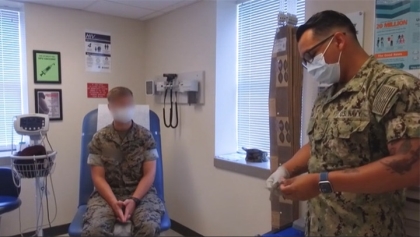
Chlamydia is the most common sexually transmitted infection in the U.S. In the photo, a service member at Naval Medical Center Camp LeJeune Community Health Clinic gets tested for STIs. (Photo: Naval Medical Center Camp LeJeune Public Affairs)
FALLS CHURCH, VA — Chlamydia is the U.S. military’s most common sexually transmitted infection (STI) among active duty servicemembers, according to 2021 and 2022 reports on STIs by the Defense Health Agency’s Armed Forces Health Surveillance Division.
In the March 2021 surveillance study, data were collected from medical encounters, reportable medical events and laboratory test results among active component U.S. Army, Navy, Air Force and Marine Corps servicemembers between 2012 and 2020.
“Chlamydia was the most common STI among the five STIs that were measured (chlamydia, gonorrhea, syphilis, genital HSV and genital HPV),” Shauna Stahlman, PhD, MPH, a senior epidemiologist at the Epidemiology and Analysis Branch Armed Forces Health Surveillance Division, told U.S. Medicine. “Rates of chlamydia among female servicemembers were about three times higher than rates in male servicemembers. However, this is likely attributed to the military’s STI screening programs, since women are screened as they enter active service and annually if they are less than 26 years old. In contrast, men may be more likely to seek sexual health care outside of the military healthcare system.”
Diagnoses of STIs were determined from medical administrative data and reports of notifiable medical events routinely provided to the Armed Forces Health Surveillance Division and maintained in the Defense Medical Surveillance System. STI cases were also derived from positive laboratory test results recorded in the chemistry and microbiology databases maintained by the Navy and Marine Corps Public Health Center at the EpiData Center, Stahlman explained in an email.
The 2021 report provides updated information about STI trends over time, which is among its most important findings. Trends in STI rates are important to monitor, because STIs can adversely impact servicemembers’ availability and ability to perform their duties. STIs also can result in serious medical conditions, such as pelvic inflammatory disease, leading to infertility among servicewomen, if left untreated, Stahlman added.
The rise in chlamydia rates isn’t exclusive to the military. Chlamydia is highly prevalent in the general U.S. population and was the most common notifiable STI in the United States in 2020. Chlamydia rates in the U.S. population are highest among adolescents and young adults.
“Therefore, it is not surprising that we see similar trends in the military population, which is a relatively young subset of the U.S. population,” Stahlman wrote. “Rates of STIs in the military as well as in U.S. civilians tend to be higher in younger individuals. STIs like chlamydia are of relatively high incidence in the military because the military is a young population, but also because servicemembers, like civilians, participate in high risk sexual behaviors that increase their risk of sustaining STIs.”
Multiple Sex Partners
A 2018 Department of Defense Health Related Behaviors Survey documented that 19.3% of servicemember respondents reported having more than one sex partner in the past year, and 34.9% reported sex with a new partner in the past year without using a condom. Chlamydia can spread easily, because it does not always cause noticeable symptoms, so it can be transmitted before someone realizes they have it, Stahlman added.
To tackle high chlamydia rates among the military, the Armed Forces Health Surveillance Division, a public health surveillance organization, will continue to promote awareness by closely monitoring rates of chlamydia and other STIs in the Armed Forces and communicating findings with stakeholders.
In addition, periodic testing for STIs and encouraging more frequent testing for high-risk groups can help to reduce transmission, because more individuals will know their STI status. Several MTFs provide local sexual health awareness and services. Servicemembers should be encouraged to use these services in addition to other resources such as the Navy and Marine Corps Sexual Health and Responsibility Program, Stahlman explained.
Men and women in the military also are informed about rising chlamydia rates and the many serious health problems caused by this sexually transmitted infection through data published annually in the Medical Surveillance Monthly Report (MSMR). STI data are also published in the Armed Forces Health Surveillance Division’s annual Department of Defense Health of the Force Report.
An updated version of the 2021 STI report, which describes STI trends between 2013 and 2021, was published in the May 2022 issue of the MSMR. The surveillance population was all active component servicemembers of the U.S. Army, Navy, Air Force or Marine Corps who served at any time during this period. Diagnoses of STIs were determined in the same manner as the 2021 report.
“Those results indicate that between 2019 and 2021, rates of all five STIs decreased or remained constant in service members of both sexes, with the exception of syphilis; syphilis rates increased in both sexes between 2020 and 2021,” Stahlman wrote. “Overall incidence rates of STIs were higher among women compared to men for genital HPV, genital HSV, gonorrhea and chlamydia. Syphilis was the only STI for which the incidence was, on average, higher among male compared to female service members.”
To reduce risk for STIs among servicemembers, continued behavioral risk reduction interventions are needed, particularly for syphilis, which has been increasing in recent years, primarily among male servicemembers, Stahlman explained.
“Because sexual health is linked not only to physical health, but also emotional and mental health, sexual health can only be achieved in the absence of stigma, shame, fear and violence,” Stahlman wrote. “Optimal sexual health programs, both in the military and in the civilian sector, should work to achieve well-being in each of these domains by promoting physical, emotional, social and mental health, while also working to remove stigma and barriers to care.”

